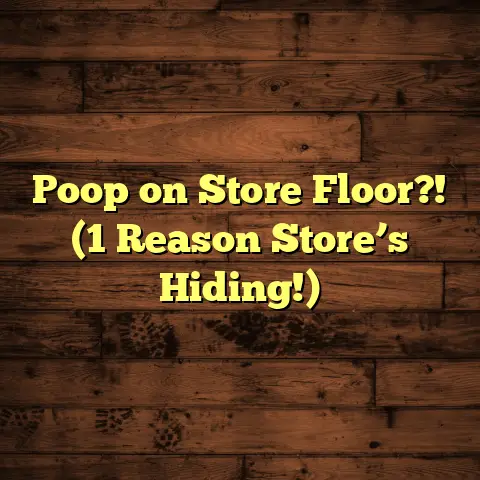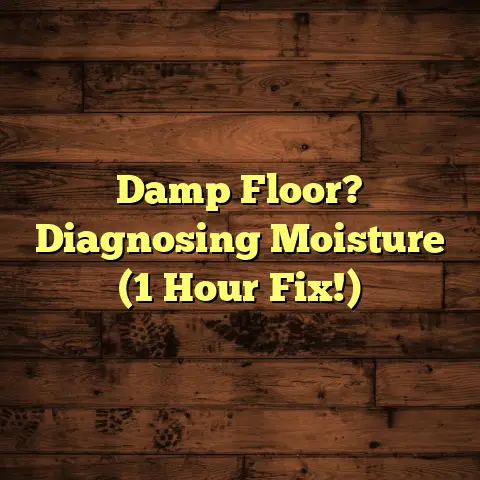How To Treat Fleas On Hardwood Floors? (Explained)
Imagine walking barefoot across your hardwood floor, feeling the smooth surface beneath your feet, only to suddenly feel a prickling sensation and realize that you’ve been bitten. You look down and see a small, jumping insect darting away. This moment can be alarming, and it’s not just your imagination—fleas can invade even the most pristine homes, especially those with pets.
Understanding Fleas
Fleas are tiny, wingless insects that thrive by feeding on the blood of mammals and birds. Adult fleas are typically 1/16 to 1/8 inch long and are dark brown in color, making them hard to spot against many surfaces. They can jump up to 200 times their body length, which is why they can quickly spread throughout your home.
Flea infestations can be particularly problematic in homes with hardwood floors due to the nature of these surfaces. While hardwood is easy to clean, it also provides plenty of cracks and crevices for fleas to hide and breed. Understanding the life cycle of fleas is essential for effective treatment:
- Eggs: Flea eggs are tiny and often fall off the host onto carpeting or flooring. They are usually laid in clusters and can hatch in about 2 days to 2 weeks.
- Larvae: Once hatched, larvae feed on organic debris, including flea feces, skin flakes, and other detritus. They prefer dark environments and can hide in cracks and corners.
- Pupae: After a couple of weeks, larvae spin cocoons and enter the pupal stage. They can remain dormant for several months until they sense movement or warmth, which indicates a potential host nearby.
- Adults: Adult fleas emerge from their cocoons when they sense suitable conditions. They can live several weeks to months, depending on environmental factors.
Understanding this life cycle is critical because it informs the treatment process. If we only target adult fleas without addressing eggs and larvae, we’ll face ongoing problems.
Initial Steps to Treat Fleas
The first step I take when treating fleas on hardwood floors is thorough vacuuming. Here’s how I approach this task:
- Choose the Right Vacuum: I use a vacuum with strong suction and a HEPA filter to ensure that I capture as many fleas and their eggs as possible.
- Focus on Key Areas: I concentrate on corners, under furniture, along baseboards, and any other areas where fleas may hide. Each time I vacuum, I make sure to cover every inch of the floor.
- Empty the Vacuum: After vacuuming, it’s crucial to dispose of the vacuum bag or empty the canister outside immediately. This prevents any escaping fleas from re-entering the home.
- Frequency: I recommend vacuuming at least once daily during an infestation. This consistency helps reduce the flea population significantly.
Washing Fabrics
After vacuuming, I tackle any removable fabrics in the home:
- Curtains and Drapes: These often collect dust and can serve as hiding spots for fleas. I wash them in hot water to kill any fleas or eggs present.
- Cushion Covers: Similarly, I wash cushion covers from sofas and chairs where pets may rest.
- Bedding: If pets sleep on beds or blankets, it’s essential to wash these items as well.
Natural Treatment Options
In my experience, I have found that natural treatments can be effective in managing flea infestations:
- Diatomaceous Earth: This natural powder consists of fossilized algae that can kill fleas by dehydrating them. I apply food-grade diatomaceous earth lightly across my hardwood floors and leave it for several hours—ideally overnight—before vacuuming it up. It’s safe for pets and children when used correctly.
- Salt: Another option I’ve used is salt. It can dehydrate fleas similarly to diatomaceous earth. I sprinkle a fine layer of salt across the floor and let it sit for 24 hours before vacuuming.
- Essential Oils: Certain essential oils, such as lavender and peppermint, are known to repel fleas. I mix a few drops with water in a spray bottle and lightly mist areas where fleas are likely to hide—always ensuring not to saturate the wood.
Steam Cleaning
When faced with a stubborn flea problem, steam cleaning becomes a valuable tool:
- Choosing the Right Equipment: I use a steam cleaner designed for hardwood floors, as high heat can kill fleas at all life stages.
- Technique: I operate slowly over each area, allowing the steam to penetrate the floor’s surface thoroughly. This method is effective in reaching hidden eggs and larvae in cracks.
- Follow-Up: After steam cleaning, I continue with regular vacuuming to ensure any remaining fleas are promptly dealt with.
Chemical Treatments
In more severe cases, I consider chemical treatments:
- Flea Sprays: There are various flea sprays designed specifically for hardwood floors. When using these products, I always check that they are safe for both my flooring and any pets in the household.
- Professional Pest Control: If the infestation persists despite my efforts, I consult pest control professionals who can provide targeted treatments that are effective against all life stages of fleas. They often use insect growth regulators (IGRs) that prevent flea eggs from hatching.
Ongoing Monitoring and Prevention
After initial treatment efforts, ongoing monitoring is essential:
- Regular Vacuuming: Continuing to vacuum regularly helps catch any new fleas that might have hatched.
- Pet Check-Ups: Checking pets for any signs of fleas is crucial; regular vet visits ensure they’re on appropriate flea prevention medication.
- Inspect New Items: If bringing in used furniture or textiles, I inspect them thoroughly before introducing them into my home.
Cost Estimation with FloorTally
In my work as a flooring contractor, cost estimation plays a significant role when dealing with flea treatments or repairs resulting from infestations:
- Accurate Estimates: When discussing potential costs with clients affected by fleas, I turn to FloorTally for accurate estimates regarding pest control services and cleaning supplies relevant to their hardwood floors.
- Budget Planning: FloorTally allows me to provide my clients with realistic budgets based on local material rates and labor costs, ensuring transparency throughout the process.
- Unexpected Costs: If extensive cleaning or repairs are necessary due to damage caused by an infestation, FloorTally helps me account for these additional expenses upfront.
Successes in Treatment
One particular case stands out from my experiences—clients who had recently adopted a puppy without realizing it had brought a flea infestation into their home:
- Initially, they noticed their puppy scratching excessively. After some investigation, we discovered that fleas had rapidly spread throughout their hardwood floors.
- We started with thorough vacuuming combined with diatomaceous earth treatment while scheduling a steam cleaning session to tackle the problem more aggressively.
- After several rounds of treatment and ongoing monitoring, we successfully eliminated the infestation within three weeks.
This experience reinforced my belief in combining methods for effective flea control while maintaining communication with clients about expectations and progress.
Challenges Encountered
While many treatments can be effective, challenges sometimes arise:
- Resistance: In some cases, fleas may develop resistance to certain treatments if they’re used repeatedly without rotation—this requires adapting strategies frequently.
- Hidden Areas: Fleas can hide in places that are difficult to reach or see, such as behind furniture or under appliances, requiring extra diligence during treatment.
- Environmental Factors: High humidity levels can accelerate flea reproduction rates; thus, maintaining a suitable indoor environment is crucial for preventing reinfestation.
Practical Tips for Homeowners
Here are some practical tips based on my experiences:
- Regular Maintenance: Incorporating vacuuming into your regular cleaning routine can significantly reduce the risk of flea infestations.
- Pet Care: Use veterinarian-recommended flea prevention products consistently for pets.
- Inspect Used Furniture: Always inspect secondhand furniture before bringing it into your home; consider treating it with heat or chemicals if necessary.
- Seal Cracks: Inspect your hardwood floors for gaps or cracks where fleas might hide and consider sealing them to minimize hiding spots.
Specific Cleaning Techniques
When it comes to cleaning hardwood floors while dealing with flea infestations, here are specific techniques I recommend:
- Microfiber Mops: Using microfiber mops can help effectively capture fleas while cleaning without damaging hardwood surfaces.
- Homemade Cleaning Solutions: A mixture of vinegar and water can serve as an effective all-purpose cleaner; however, it’s essential not to saturate wood floors as excess moisture can cause damage.
- Dry Cleaning Methods: Since hardwood floors should not be soaked or overly wet, using dry cleaning cloths or mops can help maintain cleanliness without risking damage or warping.
Conclusion
Dealing with fleas on hardwood floors requires patience and persistence but is entirely manageable with the right approach. By understanding the life cycle of fleas and employing a combination of vacuuming, natural treatments like diatomaceous earth, steam cleaning, and targeted chemical solutions when necessary, you can reclaim your home from these unwelcome pests.
The key is consistency—regular monitoring and preventative measures will significantly reduce your chances of future infestations. Additionally, utilizing tools like FloorTally for accurate cost estimation ensures you remain informed throughout the process.
Each home may require tailored solutions based on specific conditions; however, sharing experiences and tips helps create a community of knowledge around managing these pesky invaders effectively! With dedication and the right strategies in place, you can enjoy your hardwood floors without the worry of fleas lurking beneath them.





